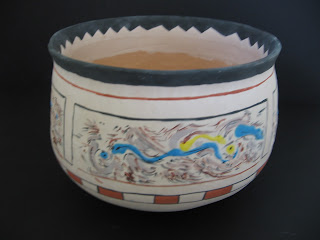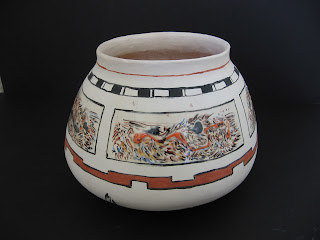I want to link this post to the one I posted on May 16 at this site. If you haven't read it you might skip back and see where I was heading with those 6 jars as I plan to show this summer at various shows. However, I now have four additional jars I want to add to that list so rather than editing that post, I'll just do a quick posting and include
a discussion of what they represent (whew, was that really one sentence??).
The first jar of this group (or #7) is below. I like to utilize Casas Grandes forms (jars, ollas, bowls?), Pueblo geometric polychorme designs to highlight the panels (in the tradition of Mexican pottery), and then kick in some panel designs that are based on the landscapes of the Yakima Valley. Flip back to my post on the photos of Jo Miles for an idea of what I try to capture with these simple line drawings. nothing too mysterious. These jars are around 10" (tall and wide). I start with a red clay form, cover it with a white slip, sometimes burnish the surface, and bisque fire it before applying the painted panels.
Let's look at another jar (#8)
Pretty much the same format. Sometimes I like a progressive landscape, either throughout the day, season, or ridge (the development of a storm for example). These simple drawings have certainly made me more aware of distinctive local ridges and their character. I like the way the scenes progress when you turn (or spin) the bowl or view it form different sides. As I approach the forms primarily from the panel images, they are more like watching TV or driving than a single, framed, canvas? The paints are ceramic glazes, fired at bisque temperatures, sometimes with a clear overglaze to bring out the colors.
The next bowl (#9) is an open mouth bowl with an abstract panel design. I like this format as it allows me a format for what I've been doing with water colors. As mentioned above, these are low fire glaze colors, typical of Maljorca or festive, low fire ceramic ware. I am trying here to complement the Casas Grandes forms, the polychrome styles, Mexican tradition and abstract painting that interests me.
One more similar jar is #10 below (the same jar at the top of this blog, different panel). An interesting thing I have found is how expressive simple bands of color are with these pots. Add to those tri-color (polychrome) lines the geometric "puebla designs" in the round and you have the basic elements of "Casas Grandes" jars.
I have never seen painted ceramic "panels" discussed as specifically traditional Mexican motifs. No doubt other cultures have utilized panels in their ceramic ware but it seems that Mexican native ware have utilized panels most effectively. I like both the formal rectangular panels found on native cups and bowls and the sketchy panels defined by brush strokes, in conjunction with other brush stroke patters which define a lot of Mexican native cups and bowls. Finally, not to repeat myself, the panels seem ideal for what would otherwise be abstract water color images, fire on the pot surface.
To recap: I feel a slip covered jar, based on native shapes, is a good starting canvas. The polychrome convention gives the viewer a familiar art form, easy to relate to, and the panels, borrowed from functional Mexican native ware, give the pot a timeless, traditional background. Canvas is unable to present the "in the round" possible with these jars.
Oh yea, at the Dova show reception we witnessed a very funny thing happen as a result of one specific "Olla characteristic". As can be imagined, these pots, though stable, are somewhat prone to wobbling a bit. They don't fall over, but they do "come alive" if jiggled. When Herb Blissard received his Larson Gallery award for living to be 150 years old, he casually leaned against the stands on which my jar was propped, with the predictable wobbling resulting. Unaware that a (precious??) work of art appeared to be ready to crash to the floor while the viewers looked on amazed, the instant was uniquely charged, as if a panther was suddenly noticed, perched from an overhanging limb, ready to pounce on the unsuspecting Herb. As an artist" I couldn't have planned a more fitting emotional moment of tension, or a more fitting memorial to our friend, Herb.
And so, the final attribute of these pots is the slight wobble they all have when setting on a table. Those who know the drill know the pot won't just tip over or roll off the table (Well, perhaps occasionally, but that just adds to the tension). Usually, they are setting on a fulcrum point (?) and will spin very easily, displaying the timeless infinity of the panel's passing. Perhaps the Casas Grandes artists were hinting at this timelessness suggestion of the pecularities of time,,, or perhaps those artists just enjoyed the unsettling promise of catastrophe against the metaphor of the shards within all of us.
Stay tuned for a 'smoke fired" update, a new post on washing unspun wool (for the buffalo farmers among us, and a long promised blurb on Raku.























